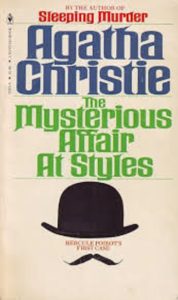Book Review: The Mysterious Affair at Styles by Agatha Christie
World War One rages in Europe, but for Captain Arthur Hastings, the fighting is over. Recovering from battle wounds, Hastings is at loose ends until invited to the country manor of his old acquaintance John Cavendish. Styles Court has changed a bit since Hastings’ childhood visits, as John’s stepmother has remarried.
The former Mrs. Cavendish is now Emily Inglethorp, having married a rather shady character named Alfred Inglethorp. Alfred has the habit of wearing dark glasses and a long beard that doesn’t quite match his other hair, making him look like someone in disguise. Emily’s stepsons are not well pleased, but Mrs. Inglethorp controls the purse strings and will have her own way.
While Emily Inglethorp is quite generous, she’s also very keen on having people show due appreciation for her largess, which can be grating. When she dies of strychnine poisoning, the obvious suspect is Alfred, who the rest of the family assumes married Emily for her money. But it could also be country squire John Cavendish who’s strapped for money; his brother Stephen, an unsuccessful poet who was medically trained; John’s wife Mary, who is beautiful but not happy in her marriage; Cynthia Murdoch, a pharmacist’s assistant who Mrs. Inglethorp had taken in; Evelyn Howard, Emily’s long-time best friend who’d recently quarreled with her, or just possibly poison expert and foreigner Dr. Bauerstein.
Hastings considers himself a bit of a detective, but all this has him a bit baffled. Fortunately, among the other beneficiaries of Mrs. Inglethorp’s generosity is a houseful of Belgian war refugees in the nearby village of Styles St. Mary, and one of the residents is the man who trained Hastings in the detective arts, former police chief Hercule Poirot. It will take all of Monsieur Poirot’s “little grey cells” to unravel this mystery!
This was Agatha Christie’s first mystery novel, written in 1916 and serialized in the Times, then published in book form in 1920. It introduces the eccentric detective Poirot, his frequent sidekick Hastings, and competent but not quite brilliant police officer Inspector Japp of Scotland Yard. This book made Ms. Christie’s reputation as a rising mystery writer.
Poirot’s age is not clear, although he had a long career in the Belgian police and thirty-year-old Hastings considers him “old.” Poirot sometimes uses words oddly in English, has an egg-shaped head, and acquired a limp during the war. He’s got a considerable ego, and enjoys twitting Hastings about the latter’s foibles. They met in Belgium some time before World War One, under circumstances never fully described.
Hastings is very much a Watson figure in this story, with a good memory but a bit thick. He’s very much the British gentleman with the traditional values of same, but does tend to let his imagination run away with him. As the narrator, this helps Agatha Christie as Poirot deliberately omits details of his thought process to keep the too-honest Hastings from alerting suspects to Poirot’s true suspicions. Hastings, is, however, good at blurting out observations that help Poirot realize key points.
Good: Poirot is a fun character, and this first novel already shows Ms. Christie’s ability to create a twisty mystery where the culprit is difficult for the casual reader to guess ahead of time.
Less good: Agatha Christie lays on the red herrings a bit too thickly; she’d get much better at tightening up her books.
There’s a bit of period anti-Semitism, and a scattering of ethnic slurs. Most notably, Hastings uses a particular slur multiple times in his narration along with slut-shaming (though never speaking that way in dialogue.) He also shows a distinct double standard when it comes to marital infidelity. Bad show, old chap.
Overall: One of Agatha Christie’s lesser books, but well worth going back to after you’ve read one or two of her later Poirot works. Do, if possible, read this one before Curtain, as that book relies on echoes from this one.
And did you know there was an Agatha Christie anime?

